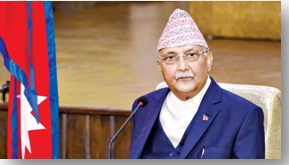

Context : Nepal is in constitutional crisis with the dissolution of Parliament.
 Background : Nepal plunged into yet another political crisis, after the Prime Minister of Nepal has dissolved the lower house of the country’s Parliament. According to Article 85 (1) and Article 76 (7) of the Constitution of Nepal, the lower house, called the Pratinidhi Sabha, has a term of five years unless dissolved earlier.
Background : Nepal plunged into yet another political crisis, after the Prime Minister of Nepal has dissolved the lower house of the country’s Parliament. According to Article 85 (1) and Article 76 (7) of the Constitution of Nepal, the lower house, called the Pratinidhi Sabha, has a term of five years unless dissolved earlier.
However, there is no provision in the Constitution that allows the Prime Minister, who is leading the two-thirds majority government, to dissolve it unilaterally. As a result, several opposition parties have taken to the streets to protest against PM’s decision, the first dissolution in the democratic history of the country.
Questions over Constitution
What has happened has left a question mark over the Constitution of 2015, and its key features like federalism, secularism and republic. There are already popular protests on the streets.
The split in a party with a two-thirds majority has raised concerns that it may lead to a systemic collapse.
History of Constitution & Its dissolution
Dissolution of the House is not new in Nepal, but this is the first such instance after the new Constitution of 2015 that places safeguards against dissolution. The new constitution does not envisage such a step without exploring formation of an alternative government.
The 1991 Constitution, scrapped in 2006, had provisions for dissolution of Parliament at the Prime Minister’s prerogative. During the time it was in force, Parliament was dissolved thrice. The first Parliament elected in 1991 was dissolved on the recommendation of Prime Minister G P Koirala after he failed to have a vote on thanks motion by the King passed in the House. The Supreme Court upheld that dissolution.
But in 1995, the Supreme Court rejected the dissolution by Prime Minister Manmohan Adhikary after a no-trust motion had been tabled but before the loss of majority was proved. The court held that the executive did not have the right to snatch an issue under consideration of the legislature.
Tensions with India widened the Rift
On 13 June, Nepal’s Parliament voted on a constitutional amendment Bill in a special session to update the country’s map, that showed the regions of Lipulekh, Kalapani, and Limpiyadhura as part of its sovereign territory.
The Nepal government’s move came after India inaugurated a road connecting India to China via Lipulek, as part of the Kailash-Mansarovar pilgrimage route. Nepal claims that the newly-built road traverses its territory.
At that time the Prime Minister of Nepal had alleged that politicians in the country were being instigated by India with the intention of removing him from power. After his comments, leaders of the ruling party renewed calls for his resignation.
The prime minister's remarks that India was conspiring to remove him was neither politically correct, nor diplomatically appropriate. However, India denying such allegations. But, that statement had undermined the relationship with India.
The China factor
China has been a big factor in Nepal’s internal politics since 2006. It is seen as having lobbied, visible or secret, to prevent the split. China has also invested in crucial sectors like trade and Investment, energy, tourism and post-earthquake reconstruction, and is Nepal’s biggest FDI contributor. It has increased its presence in Nepal because of a perception that India played a crucial role in the 2006 political change.
Conclusion
The matter is now pending before Nepal’s Supreme Court. If the court finds that the decision of the Prime Minister somewhere violated constitutional provisions, he will have to resign as prime minister. If not, the interim government will continue till the next elections that have been scheduled in two phases on 30 April and 10 May.
Connecting the Article
Question for Prelims : Lipulekh Pass links
(a) Uttarakhand with Tibetan.
(b) Himachal with Uttarakhand
(c) Sikkim with Uttarakhand
(d) None of the above
Question for Mains : Discuss the impact of Nepal's constitutional crisis on Asia and India's relations with China. How can India effort to r

Our support team will be happy to assist you!
